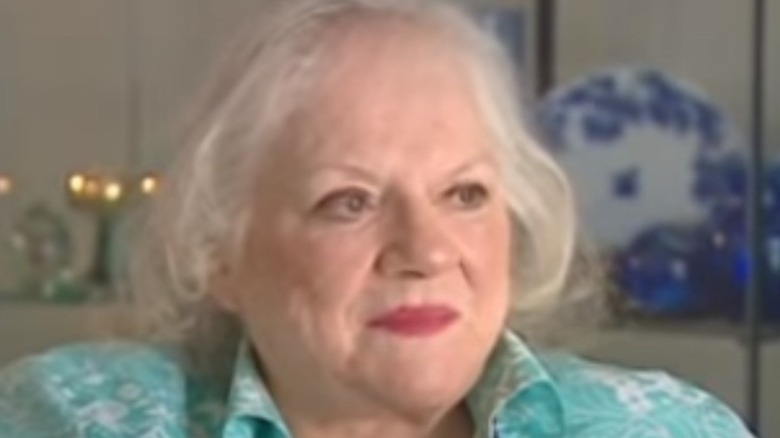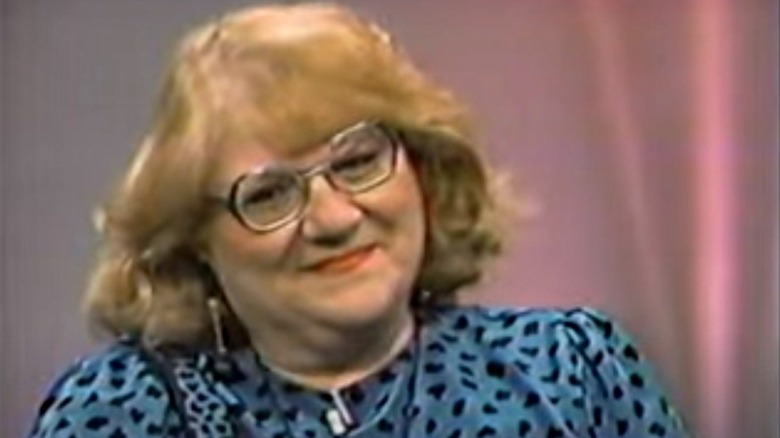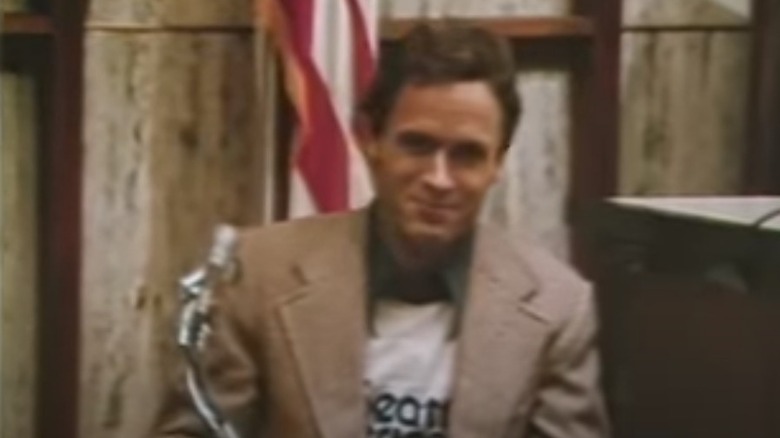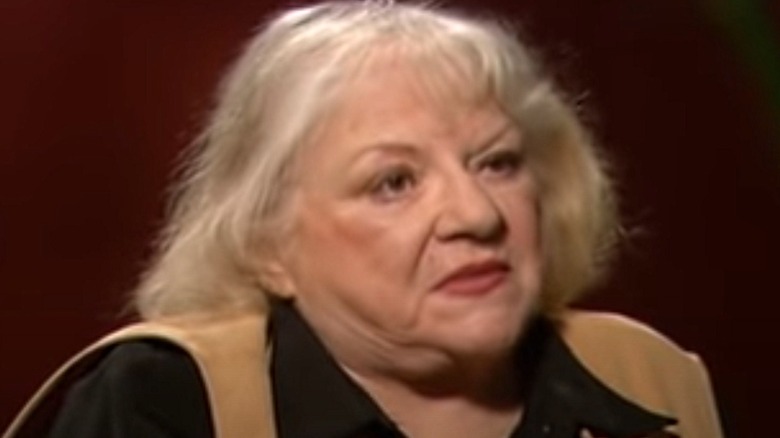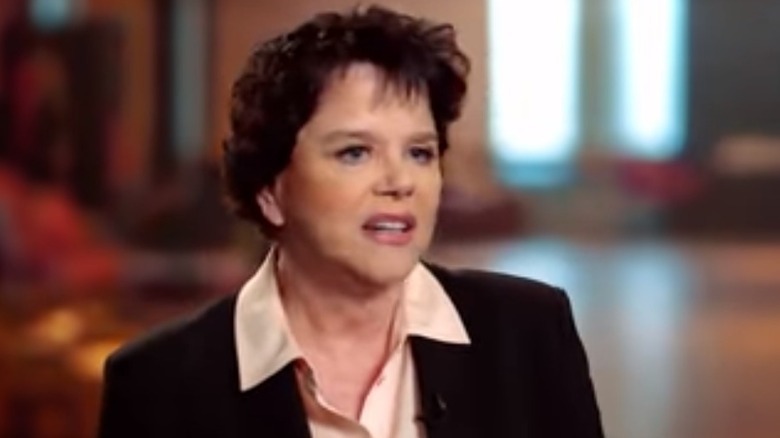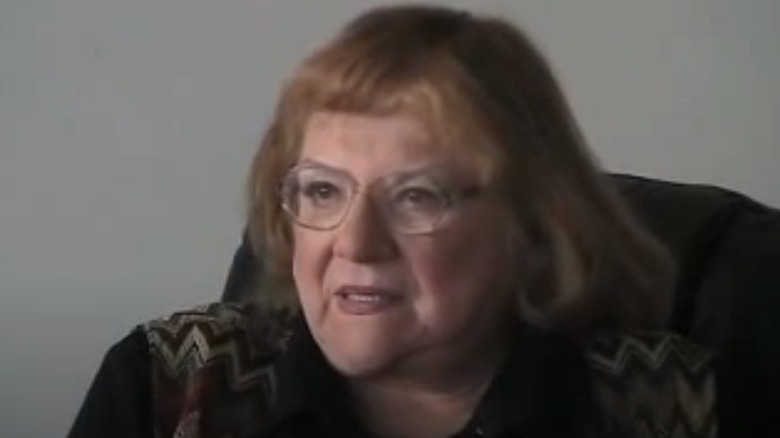The Untold Truth Of Ann Rule
Books and documentaries about real-life murder and mayhem are nothing new. Among the first publications to seriously explore true crime was the lurid pulp magazine, True Detective. Beginning in 1924, True Detective (originally "True Detective Mysteries"), brought readers graphic accounts of actual murder investigations delivered in the hardboiled style of such writers as Dashiell Hammett. Reaching a peak in the 1940s and '50s before declining in the '60s, true crime magazines all but disappeared by the 1990s.
Still, the true crime genre thrived. Thanks to such books as Truman Capote's "In Cold Blood," detailing the 1959 slaughter of the Clutter Family and the subsequent trials of killers Richard Hickock and Perry Smith, and "Helter Skelter," former Los Angeles district attorney Vincent Bugliosi's gripping account of the 1969 Tate-Labianca murders, the public's appetite for detailed accounts of history's most heinous crimes has meant big business for publishing houses and decades of sleepless nights for readers.
The last decade, however, has seen an exponential boom in interest in true crime and a plethora of content ranging from documentaries such as Netflix's "Making a Murderer" to countless podcasts and online videos devoted to the genre. One of the figures most responsible for pop culture's ongoing obsession with true crime is the late author Ann Rule. Beginning with "The Stranger Beside Me," her bestselling 1980 account of the life and crimes of serial killer Ted Bundy, Rule redefined crime writing for a generation. This is her story.
Born investigator
As documented on her now defunct website, Ann Rule was born in Lowell, Michigan to parents Chaster R. Stackhouse and Sophie Hansen Stackhouse. Known to his friends as "Stack," Rule's father coached football, basketball, and track. Her mother was a devoted school teacher who worked with developmentally disabled children.
Rule's career path, however, was shaped by her maternal grandfather, a Stanton, Michigan sheriff. An uncle who was also a sheriff, another who was a medical examiner, and a cousin who worked as a district attorney were equally influential to the future crime author.
Young Ann spent her vacations helping out at her grandfather's jail in Stanton. "My Grandpa Hansen was the sheriff of Montcalm County. So, if I wanted to go visit grandma and grandpa, I had to literally go to jail," Rule explained to Seattle PBS affiliate KCTS-TV's Enrique Cerna. "My grandma would cook for the prisoners, and I would push the meals through a slot in the pantry wall ... I would always ask my grandpa, 'Well, why are they locked up? ... Why do they want to grow up to be criminals?' I was about 7 ... and I didn't know yet about kids who had unhappy childhoods and all kinds of things that predestined them sometimes for a life of crime." That one innocent childhood question became a guiding obsession for Rule, and, at an early age, she knew she was destined for a career in law enforcement. Nevertheless, fate had a very different future in store for Ann Rule.
Officer Ann Rule
Spurred on by her family's long history in criminal investigation and law enforcement and her obsessive desire to understand the criminal mind, Ann Rule seemed destined for a career as a police officer. "It's funny. I knew one thing I didn't want to do was be a writer," Rule told KCTS-TV's Enrique Cerna. "In fourth grade, I thought, 'That's too hard' ... but I was always fascinated from the time I was 5, probably, if I heard sirens in the night, I wanted to go [see what was happening]."
Her father's job as a coach required an often nomadic lifestyle for Rule's family. After graduating from Coatesville High School in Pennsylvania, Rule made her way to the Pacific Northwest where she attended Seattle's University of Washington. Despite her childhood misgivings, Rule had a real talent for writing, and in her own words, writing was an "easy A." She graduated from UW with a bachelor's degree in creative writing and minors in psychology, criminology, and penology.
After college, Rule joined the Seattle police where, according to CBS News, the rookie cop was the youngest policewoman ever hired by the department. Unfortunately, Rule's time on the force was short-lived because of her poor vision. "I'm so nearsighted," Rule said. "I couldn't see the big 'E.' I couldn't see the wall behind the big 'E' ... I washed out after a year and a half, and it just broke my heart because I loved that job so much."
Crime fighter to crime writer
Although Ann Rule lost her dream job as a Seattle police officer, her passion for criminology continued. She returned to school, earning an associate's degree in criminal justice and taking a job as a social worker. It was then that Rule realized she could combine her interest in law enforcement with her love of writing.
After receiving a flurry of rejection slips, Rule broke through with an article for the Seattle PI's Sunday magazine. "Then, I sold some to the Seattle Times Sunday magazine," Rule told KCTS-TV. "I sold a bunch of true confessions until I ran out of things to confess!" Soon, Rule was contributing to such magazines as Cosmopolitan, Ladies' Home Journal, Good Housekeeping, and Reader's Digest.
As reported by the New York Times, Rule began writing for True Detective in 1969, thus launching her career as a crime writer. For the next 13 years, Rule wrote two 10,000-word articles a week for the venerable magazine. While she was with True Detective, Rule was forced to write under several male pseudonyms. "My editor said, 'Our readers will not believe that a female knows anything about police investigation,'" Rule explained. Although writing under such names as "Andy Stack" was frustrating, Rule found that anonymity had its benefits. She continued to use pen names even after her editor gave her byline the greenlight. "By that time, I realized that many of the people I wrote about might well be out on the street ... So I stayed Andy Stack." said Rule.
Encounter with a monster
As recounted in her bestselling first book, "The Stranger Beside Me," Ann Rule was a 34-year-old mother of four on the brink of divorce when she met and became fast friends with a brilliant and handsome, 24-year-old University of Washington psychology major named Ted Bundy.
Rule, a struggling freelance writer, had been working as the Northwest correspondent for True Detective since the late 1960s, covering major crimes on a beat stretching from Eugene, Oregon, to the Canadian border. Although she could call herself a professional, she was hardly getting rich with her writing.
In 1971, Rule, who had worked as a caseworker for the Washington state Department of Public Assistance (via CBS News) and studied psychology, took a volunteer position that was well-suited to her skills — answering a hotline for the Seattle Crisis Clinic. The Crisis Center's interview and onboarding process was grueling, but Rule proved herself a talented and empathetic listener. Soon, she was ready to man the phones on the night shift. By her side was the clean-cut work-study student Ted Bundy who, in just a few short years, would be known as one of the most notorious serial killers of all time. Years later, Rule would note with irony that she saw the infamous killer save lives on the crisis line time and again. Over the long nights, Bundy and Rule came to confide in each other. Bundy expressed unwavering belief in Rule's abilities as a writer and offered her advice about her crumbling marriage.
The Stranger Beside Me
Ann Rule and Ted Bundy slowly drifted apart following the author's exit from the Crisis Clinic in 1972. Bundy, a conservative Republican, became more interested and active in politics. As detailed in Rule's "The Stranger Beside Me," Bundy, with his sights set on a law degree, went to work for the Committee to Re-elect Washington Governor Dan Evans in the fall of 1972. Rule saw Bundy for what she expected would be the final time in December 1973 at a Crisis Clinic Christmas Party, unaware that he would soon change her life forever.
Beginning in 1974, Seattle was rocked by a series of brutal murders of young women. Rule began chronicling the crimes for a proposed book. As the details of the crimes slowly unfolded, it soon became apparent that Rule's friend — handsome, charismatic, and seemingly empathetic Ted Bundy – was the prime suspect. When Rule signed her contract for the book that would become "The Stranger Beside Me," she had assumed that she was writing a detached account of the investigation of a series of violent Seattle-area slayings committed by an anonymous killer. The book, first published in 1980, turned into a deeply personal, decade-long account of the crimes and trial of a cross-country serial killer whom she had counted as a close friend. With "The Stranger Beside Me," Rule scored her first bestseller, and, in the words of publisher Simon and Schuster's president, "reinvented the true crime genre" (via The Washington Post).
Ann Rule made crime pay
Ann Rule's groundbreaking first book "The Stranger Beside Me" established the author as the true crime genre's leading voice and was the first of Rule's 35 New York Times bestsellers. Rule's next book, "Lust Killer," published in 1983, detailed the investigation of killer and necrophile Jerome Brudos whose sadistic sexual fetishes led him to brutally murder at least four women in Oregon in the late 1960s. Rule would publish two more bestsellers between 1983 and 1984: "The Want-Ad Killer" about serial murderer Harvey Carignan and "The I-5 Killer," which chronicles the crimes of high school football star — and killer – Randall Woodfield (via Sports Illustrated). Although those three books were initially released under Rule's Andy Stack pseudonym, the popularity of "The Stranger Beside Me" meant it would see subsequent printings published under her own name.
Most of Rule's books focused on murders committed in and around the Pacific Northwest (via the Washington Post). Rule also had a very specific formula for determining which cases she could develop into compelling true crime exposés. "I have to find the right subject ... I'm always looking for somebody who is charismatic, intelligent, attractive, rich, successful, has love ... the things that the rest of us think, if we had that, we'd be happy. But these people are insatiable," Rule explained in an interview with Barbara Peters of Arizona's Poisoned Pen Press and Bookstore. "I go through 300 or 400 cases to find the right subject. Then, the book almost tells itself."
One of Ann Rule's books became an acclaimed TV movie
Another of Ann Rule's best known works is her 1987 book "Small Sacrifices," which documents the bizarre case of Diane Downs.
As detailed by ABC News' "20/20,” in the spring of 1983, Diane Downs shot her three children, killing her 7-year-old daughter, Cheryl, and severely wounding both her 3-year-old son, Danny, and 8-year-old daughter, Christie. After shooting herself in the left forearm, Downs drove herself and her children to Springfield, Oregon's McKenzie-Willamette Hospital (via TruTV) claiming that a "bushy-haired" stranger had attempted to kill them in a carjacking gone wrong. Downs' odd behavior and inconsistencies in her account of the incident immediately raised red flags with police and hospital workers. Investigators soon determined Downs was obsessed with a married man with whom she had been having an affair, and that she attempted to murder her children in order to eliminate them as an obstacle to their relationship. Her surviving daughter, Christie, identified Downs as the actual assailant, and Downs was sentenced to life plus 50 years in prison (via TruTV). Rule and Downs famously clashed on a 1988 episode of "Oprah," with the true crime author systematically dismantling Downs' claims.
In 1989, "Small Sacrifices" was adapted as a made-for-TV film. Starring Farrah Fawcett as Diane Downs, "Small Sacrifices" riveted audiences over two nights on ABC. The film was met with critical acclaim, garnering Emmy nominations for outstanding miniseries and outstanding editing, as well as a nomination for outstanding lead actress in a miniseries for Fawcett. Most impressively, "Small Sacrifices" was honored with a 1990 Peabody Award.
Too close to Ted Bundy?
As reported by Victoria Beale of "The New Yorker," a close examination of "The Stranger Beside Me" reveals a number of potential ethical problems in Ann Rule's handling of her relationship with Ted Bundy. Put simply, just when was Ann Rule aware of Bundy's guilt? As Beale outlines, despite Rule's close friendship with Bundy built over many long nights at the Crisis Clinic, she was disturbed enough by a description of a suspect who approached a woman at Lake Sammamish State Park to contact a Seattle homicide detective about Bundy. Still, Rule initially dismissed Bundy as a viable suspect despite her own obvious concerns (via "The Stranger Beside Me").
When Bundy contacted Rule, who was working closely with the Seattle Police at the time of the murders, to ask why his law school records were being subpoenaed, she contacted the major crimes unit who informed her that Bundy was one of 1,200 people being checked out in a routine inquiry. Weeks later, Bundy was arrested, and the shape of Rule's book about the Seattle area murders changed radically. Beale writes, "The cynic's game is wondering how early [Rule] began to weigh the profitability of her connection, and how far it informed her actions."
According to the Washington Post, though Rule's fondness for Bundy largely disappeared as the details of his crimes came to light, she remained at least somewhat ambivalent about her former friend. "He had good in him," Rule told KCTS9, "But it was far overpowered by this addiction ... to murder."
More controversies
Ann Rule's 2003 book "Heart Full of Lies" recounts the story of Liysa Northon. In 2000, Northon fatally shot her Hawaiian Airlines pilot husband, Chris, while on a camping trip with their small son in the forests of eastern Oregon. Despite Northon's insistence that she had been a victim of domestic abuse and acted in self-defense, Rule contended that Northon was a manipulative sociopath whose greed led her to murder her husband in cold blood in a plot to collect on his life insurance. Northon pled guilty to manslaughter and served 12 years in prison.
As reported by Courthouse News Service, Northon attempted to sue Rule for defamation over statements made in "Heart Full of Lies." The suit was dismissed, and Rule was awarded $21,000 in attorney's fees. Northon's other appeal also failed, and Rule was awarded more than $60,000 in legal fees. In 2011, freelance journalist Rick Swart accused Rule of "sloppy storytelling" in a Seattle Weekly cover story. In turn, Rule unsuccessfully sued Swart and the magazine for defamation. Although Rule failed in court, she was vindicated when Seattle Weekly was forced to amend the story when it was discovered Swart was engaged to Northon.
As for "Heart Full of Lies," Rule stuck by her story, telling The Oregonian, "I certainly didn't make up anything. It was all in the files and the transcripts. I couldn't find any real indication that Liysa had been battered, not by Chris."
Ann Rule's shady sons
In 2013, Rule suffered a serious fall and broke her hip while on tour for her book, "Practice to Deceive." The accident marked the beginning of a downward spiral of poor health for the crime writer. Relying on a wheelchair for mobility and dependent on oxygen, she remained in good spirits, lamenting to Psychology Today's Cathy Scott that her injury caused her to miss a deadline for the first time in her long career.
However, as reported by the Huffington Post, Rule's sons Michael and Andrew took advantage of their mother's incapacitation, using abusive tactics to bilk her out of over $100,000. In 2015, the two were charged with theft and forgery. According to court documents, Michael would "yell at his mother demanding money while she cowered in her wheelchair" and Andrew allegedly screamed obscenities at the ailing woman until she would write him a check.
If you or someone you know is dealing with domestic abuse, you can call the National Domestic Violence Hotline at 1−800−799−7233. You can also find more information, resources, and support at their website.
Her daughter Leslie Rule is also an author
Like her mother Ann, Leslie Rule is an author whose work skews toward dark themes. Having inherited her mother's prodigious talent for writing as well as her curiosity, the younger Rule has chosen to concentrate on ghostly encounters and the paranormal.
As documented in Leslie's 2004 book, "Ghosts Among Us," her mother introduced Leslie and her friends to Ted Bundy while working at the Seattle Crisis Clinic. Leslie, then 14, didn't share her friends' assessment of Bundy as "cute," instead describing him as "icky." Rule revealed in a 2020 Publisher's Weekly interview that she helped her mother with her articles and began attending trials at age 17.
With 2020's "A Tangled Web," Leslie Rule followed in her mother's footsteps. Her first true crime book, "A Tangled Web," tells the strange story of murderer Shanna Golyar who killed her romantic rival, Cari Farver, and spent years impersonating the dead woman online.
The tragic death of Ann Rule
In October 2013, Ann Rule was scheduled to take part in a book signing event in Freeland, Washington, to promote her latest work "Practice to Deceive," an in-depth examination of the 2003 murder of Russell Douglas, whose body was found in an SUV on a lonely road on Whidbey Island. As reported by the Whidbey News-Times, Rule fell while staying at a Freeland motel. The author broke her hip in the accident and was hospitalized. The following Monday, she underwent surgery.
Sadly, the fall proved to be the start of a downward spiral for the famous crime writer. In her final years, Rule was in a wheelchair, relied on oxygen, suffered from periods of "extreme confusion," and, as reported by the Huffington Post, was unable to conduct her daily life without assistance. Suffering from pneumonia and a number of other ailments (via Seattle PI), Rule died of congestive heart failure on July 26, 2015 (via Seattle Times). She was 83.
